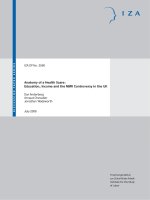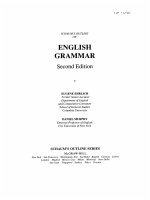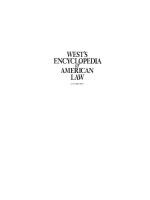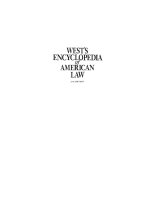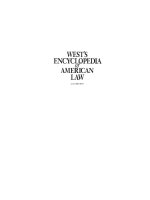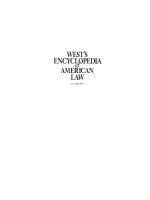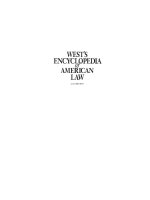- Trang chủ >>
- Y - Dược >>
- Ngoại khoa
oxford handook of occupational health 2nd ed
Bạn đang xem bản rút gọn của tài liệu. Xem và tải ngay bản đầy đủ của tài liệu tại đây (3.92 MB, 944 trang )
OXFORD MEDICAL PUBLICATIONS
Oxford Handbook of
Occupational
Health
I_Smedley_prelims.indd 1 12/24/2012 3:50:47 PM
Published and forthcoming Oxford Handbooks
Oxford Handbook for the
Foundation Programme 3e
Oxford Handbook of Acute
Medicine 3e
Oxford Handbook of Anaesthesia 3e
Oxford Handbook of Applied Dental
Sciences
Oxford Handbook of Cardiology 2e
Oxford Handbook of Clinical and
Laboratory Investigation 3e
Oxford Handbook of Clinical
Dentistry 5e
Oxford Handbook of Clinical
Diagnosis 2e
Oxford Handbook of Clinical
Examination and Practical Skills
Oxford Handbook of Clinical
Haematology 3e
Oxford Handbook of Clinical
Immunology and Allergy 3e
Oxford Handbook of Clinical
Medicine – Mini Edition 8e
Oxford Handbook of Clinical
Medicine 8e
Oxford Handbook of Clinical Pathology
Oxford Handbook of Clinical
Pharmacy 2e
Oxford Handbook of Clinical
Rehabilitation 2e
Oxford Handbook of Clinical
Specialties 9e
Oxford Handbook of Clinical
Surgery 4e
Oxford Handbook of Complementary
Medicine
Oxford Handbook of Critical Care 3e
Oxford Handbook of Dental Patient
Care 2e
Oxford Handbook of Dialysis 3e
Oxford Handbook of Emergency
Medicine 4e
Oxford Handbook of Endocrinology
and Diabetes 2e
Oxford Handbook of ENT and Head
and Neck Surgery
Oxford Handbook of Epidemiology for
Clinicians
Oxford Handbook of Expedition and
Wilderness Medicine
Oxford Handbook of Gastroenterology
& Hepatology 2e
Oxford Handbook of General
Practice 3e
Oxford Handbook of Genetics
Oxford Handbook of Genitourinary
Medicine, HIV and AIDS 2e
Oxford Handbook of Geriatric
Medicine
Oxford Handbook of Infectious
Diseases and Microbiology
Oxford Handbook of Key Clinical
Evidence
Oxford Handbook of Medical
Dermatology
Oxford Handbook of Medical Imaging
Oxford Handbook of Medical
Sciences 2e
Oxford Handbook of Medical Statistics
Oxford Handbook of Nephrology and
Hypertension
Oxford Handbook of Neurology
Oxford Handbook of Nutrition and
Dietetics 2e
Oxford Handbook of Obstetrics and
Gynaecology 2e
Oxford Handbook of Occupational
Health 2e
Oxford Handbook of Oncology 3e
Oxford Handbook of
Ophthalmology 2e
Oxford Handbook of Oral and
Maxillofacial Surgery
Oxford Handbook of Paediatrics 2e
Oxford Handbook of Pain Management
Oxford Handbook of Palliative Care 2e
Oxford Handbook of Practical Drug
Therapy 2e
Oxford Handbook of Pre-Hospital
Care
Oxford Handbook of Psychiatry 3e
Oxford Handbook of Public Health
Practice 2e
Oxford Handbook of Reproductive
Medicine & Family Planning
Oxford Handbook of Respiratory
Medicine 2e
Oxford Handbook of Rheumatology 3e
Oxford Handbook of Sport and
Exercise Medicine
Oxford Handbook of Tropical
Medicine 3e
Oxford Handbook of Urology 3e
I_Smedley_prelims.indd 2 12/24/2012 3:50:47 PM
Oxford Handbook of
Occupational
Health
Second Edition
Edited by
Dr Julia Smedley
Consultant Occupational Physician,
Lead consultant Occupational Health,
University Hospital Southampton
NHS Foundation Trust, and
Honorary Senior Lecturer,
University of Southampton, UK
Dr Finlay Dick
Senior Occupational Physician,
Capita Health and Wellbeing,
Aberdeen, and Honorary
Senior Lecturer in Occupational
Medicine, University of
Aberdeen, UK
Dr Steven Sadhra
Senior Lecturer and Director
of Education for Occupational
Health, Institute of Occupational
and Environmental Medicine,
College of Medical and
Dental Sciences, University of
Birmingham, UK
1
I_Smedley_prelims.indd 3 12/24/2012 3:50:47 PM
Great Clarendon Street, Oxford, OX2 6DP,
United Kingdom
Oxford University Press is a department of the University of Oxford.
It furthers the University’s objective of excellence in research, scholarship,
and education by publishing worldwide. Oxford is a registered trade mark of
Oxford University Press in the UK and in certain other countries
© Oxford University Press, 2013
The moral rights of the authors have been asserted
First edition published 2007
Second edition published 2013
Impression: 1
All rights reserved. No part of this publication may be reproduced,
stored in a retrieval system, or transmitted, in any form or by any means,
without the prior permission in writing of Oxford University Press,
or as expressly permitted by law, or under terms agreed with the appropriate
reprographics rights organization. Enquiries concerning reproduction
outside the scope of the above should be sent to the Rights Department,
Oxford University Press, at the address above
You must not circulate this book in any other binding or cover and you must
impose the same condition on any acquirer
British Library Cataloguing in Publication Data
Data available
ISBN 978–0–19–965162–7
Printed in China by
C&C Offset Printing Co. Ltd.
Oxford University Press makes no representation, express or implied, that the drug
dosages in this book are correct. Readers must therefore always check the product
information and clinical procedures with the most up-to-date published product
information and data sheets provided by the manufacturers and the most recent
codes of conduct and safety regulations. The authors and the publishers do not
accept responsibility or legal liability for any errors in the text or for the misuse or
misapplication of material in this work. Except where otherwise stated, drug dosages
and recommendations are for the non-pregnant adult who is not breast feeding.
3
I_Smedley_prelims.indd 4 12/24/2012 3:50:47 PM
v
Preface
This second edition of the former newcomer to the handbook series cov-
ers the broad fi eld of occupational health (OH) and wellbeing. It is aimed
primarily at occupational health professionals from all disciplines, including
general practitioners (GPs) who practise OH on a sessional basis and a
new breed of non-medical case managers who advise on occupational
rehabilitation. The book will also be useful for trainees in occupational
medicine who are preparing for professional examinations.
We have retained the basic structure and features of the fi rst edition
which received good feedback from readers. Six main areas (occupational
hazards, occupational diseases, OH practice, specialist disciplines, practi-
cal procedures, and emergencies) are covered in twelve sections. The
new edition still provides a ‘quick look-up’ tool (particularly for specifi c
hazards and diseases), and gives a structured overview of some important
operational issues such as service provision and the legal framework. The
specialist chapters (occupational hygiene, toxicology, epidemiology, envi-
ronmental medicine, and safety science) aim to give an overall approach
to problem-solving, helping to identify the need for (and interpretation
of) specialist advice. The inevitable overlap between topics has been mini-
mized by cross-referencing other pages in the handbook, but we have
deliberately retained limited duplication where this avoids excessive ‘fl it-
ting’ between pages.
The new material for the second edition refl ects developments in the
fi eld of OH and the increasing web-based information store. The principal
changes are:
• The updating and signposting of evidence-based and other important
guidance where applicable for each topic, including more web
references than the previous edition
• A new emphasis on wellbeing to refl ect the changing role of OH
practitioners in optimizing health at work, and minimizing the negative
impact of work loss on health
• New pages on managing chronic pain, psychological therapies,
managing psychiatric emergencies, REACH legislation, obesity, policy
writing, voice disorders, and evidence-based guidelines in OH.
We hope that the second edition will be as successful as the fi rst, and
look forward to hearing your feedback via the OUP website (M http://
www.oup.com/uk/medicine/handbooks). We are particularly interested in
views on the overall emphasis and level of detail of pages, and any topics
that we have omitted.
JS
FD
SS
January 2012
II_Smedley_preface.indd v 1/2/2013 1:20:33 PM
vi
Acknowledgements
We would like to give special thanks to those who supported us during
the revision of this handbook.
JS is indebted to her tolerant and supportive family, Andrew, Ben,
and Alex. FD thanks his family, Smita, Ananya, Cara, and Rohan for their
encouragement and support. SS thanks his family, in particular his parents
Tarsem Singh and Gurdev Kaur for their encouragement and for the work
ethic they instilled in him.
We also thank Michael Hawkes from OUP who helped to keep us on
track.
Contributors
The following colleagues kindly gave up their time to update topics, or to
contribute the initial drafts for new topics or chapters.
Professor Jon Ayres, Dr David Brown, Dr John Cherrie, Professor David
Coggon, Dr Hilary Cross, Dr Steve Deacon, Dr Mike Doig, Dr Clive
Harker, Dr Kit Harling, Dr Max Henderson, Professor Craig Jackson, Dr
Bob Jefferson, Professor Susan Klein, Professor Diana Kloss, Professor
Ewan Macdonald, Dr Ira Madan, Dr Stuart Mitchell, Professor Keith Palmer,
Dr Cathy Price, Dr Paul Sclare, Dr Alan Smith, Dr Jon Spiro, Dr Andrew
Wheatley, and Dr Nerys Williams.
Expert advisers
We are particularly grateful to Dr Fortune Ncube who gave extremely
helpful comments on fi tness for exposure prone procedures.
III_Smedley_Acknowledgment.indd vi 1/2/2013 1:20:54 PM
vii
Foreword
The plain clear message at the centre of this authoritative text is that occu-
pational medicine is preventive medicine practised in the workplace—
safeguarding and promoting health and wellbeing among the workforce.
Occupational health is now seen as a major aspect of public health.
Specialist services have a responsibility both to respond effectively to
unforeseen threats to individual and population health arising in the con-
text of working life, and wherever possible to act to prevent work-related
ill-health.
Whilst the Handbook is a detailed and comprehensive text for special-
ists in occupational health it also meets important needs of a much wider
readership. The tenets of occupational health are increasingly observed
by other health professionals, and by farseeing employers, largely because
of evidence that being in work is generally good for health and wellbeing
and worklessness is harmful, and also because not being wholly fi t is still
compatible with work of the right kind.
The Handbook reinforces the view that safeguarding health at work,
preventing loss of occupation as a result of ill health, and supporting
prompt treatment and rehabilitation to enable people to return to work
following absence through illness or injury, are not for occupational health
services alone. They are joint enterprises requiring collaboration between
employers and occupational health services, the services set up under
health and safety legislation, and the NHS.
Issues arising in the practice of occupational health are not limited to
specialists in this discipline. They are also the concerns of other people
whose advice and actions can infl uence the balance of understanding
between employer and employee, especially when the employee is a
patient under the care of other health professionals.
The Handbook is a source of guidance on the occupational signifi -
cance of many health conditions. This information serves to strengthen
clinical management, relieving uncertainty about the implications of ill-
ness for working life, and enabling sound advice on the steps to be
taken for the best outcome. The Handbook contains information that
should be readily accessible to any professional in primary and second-
ary health care.
At a time marked by an inescapable awareness of serious inequalities
in health and life chances, and a climate of economic stringency, we have
become familiar with the costs, burdens, and social consequences of
impaired health among working age people.
There is widening recognition of the interplay of health with work and
of work and the conditions of work with health, and of the many factors
that infl uence health, health beliefs, and behaviour. Often they are deeply
embedded in the history and culture of societies. Some can be changed for
the better and that is what the practice of a more fully engaged occupation
IV_Smedley_foreword.indd vii 1/2/2013 1:21:20 PM
viii
health discipline aims to do. Such engagement requires further changes in
culture and in practice, and in the education and training of professionals
in health care, and in business and management, necessary to bring about
those changes. The Handbook provides a vade mecum in this task.
Professor Dame Carol Black
National Director for Health and Work
June 2012
FOREWORD
IV_Smedley_foreword.indd viii 1/2/2013 1:21:20 PM
ix
Contents
Preface v
Acknowledgements vi
Foreword vii
List of contributors xii
Symbols and abbreviations xiv
Section 1 Occupational hazards
1 Physical hazards
3
2 Chemical hazards
41
3 Biological hazards
103
4 Mechanical and ergonomics hazards
117
5 Psychosocial hazards
133
Section 2 Occupational diseases
6 Occupational infections
149
7 Respiratory and cardiovascular disorders
197
8 Skin disorders
241
9 Musculoskeletal disorders
253
10 Gastrointestinal and urinary tract disorders
263
11 Eye disorders
277
12 Neurological disorders
287
13 Psychiatric disorders
305
14 Reproductive disorders
317
15 Haematological disorders
323
16 Medically unexplained occupational disorders
331
V_Smedley_contents.indd ix 1/2/2013 3:17:40 PM
CONTENTS
x
Section 3 Occupational health practice
17 Operational issues
339
18 Ethics
359
19 Policies
365
20 Sickness absence, rehabilitation, and retirement
393
21 Principles of risk assessment and risk management
415
22 Health surveillance
423
Section 4 Fitness for work
23 Generic fi tness for work issues and
specifi c disorders
443
24 Fitness for specifi c work
471
Section 5 Occupational health law
25 UK health and safety legislation
509
26 Employment law
557
27 Legislation related to occupational
health records
577
28 Environmental legislation
585
Section 6 Occupational hygiene
29 Occupational hygiene overview
597
30 Monitoring exposure
603
31 Biological monitoring
623
32 Prevention and control of exposure
633
Section 7 Toxicology
33 Principles of toxicology
671
Section 8 Epidemiology in occupational health
34 Epidemiology
683
V_Smedley_contents.indd x 1/2/2013 3:17:40 PM
CONTENTS
xi
Section 9 Environmental medicine
35 Environmental protection
709
Section 10 Safety science
36 Safety science 727
Section 11 Practical procedures
37 Clinical tasks and procedures
747
38 Non-clinical tasks and procedures
771
Section 12 Emergencies in occupational health
39 Acute poisoning
791
40 Non-chemical emergencies
813
41 Terrorism
827
Appendices 835
Index 891
V_Smedley_contents.indd xi 1/2/2013 3:17:40 PM
xii
List of contributors
Professor Jon Ayres
Professor of Environmental and
Respiratory Medicine, Institute of
Occupational and Environmental
Medicine, University of
Birmingham, UK
Dr David Brown
Consultant Occupational
Physician, EDF-Energy Nuclear
Generation, Gloucester, UK
Dr John Cherrie
Research Director, Institute of
Occupational Medicine,
Edinburgh, UK
Professor David Coggon
Professor of Occupational and
Environmental Medicine, MRC
Lifecourse Epidemiology Unit,
University of Southampton,
Southampton, UK
Dr Hilary Cross
Honorary Senior Lecturer
in Occupational Toxicology,
Institute of Occupational and
Environmental Medicine, College
of Medical and Dental Sciences,
University of Birmingham, UK
Dr Steve Deacon
Consultant Occupational
Physician, Avondale Medical
Consultancy Ltd, Waltham on the
Wolds, Leicestershire, UK
Dr Finlay Dick
Senior Occupational Physician,
Capita Health and Wellbeing,
Aberdeen, and Honorary
Senior Lecturer in Occupational
Medicine, University of
Aberdeen, UK
Dr Mike Doig
Regional Medical Manager,
Chevron Corporation,
London, UK
Dr Clive Harker
Consultant Occupational Physician,
Occmed Ltd, Carlisle, UK
Dr Kit Harling
Retired Consultant Occupational
Physician, Devon, UK
Dr Max Henderson
Consultant Psychiatrist, Institute
of Psychiatry, Kings and The
Maudsley, Senior Lecturer in
Epidemiological & Occupational
Psychiatry, Kings College London,
Institute of Psychiatry, Weston
Education Centre, London, UK
Professor Craig Jackson
Professor of Occupational Health
Psychology/Head of Psychology,
Birmingham City University,
Birmingham, UK
Dr Bob Jefferson
Consultant in Environmental
Medicine & Deputy Director,
Medical Toxicology Centre,
Newcastle University, UK
Professor Susan Klein
Director, Aberdeen Centre for
Trauma Research, Institute for
Health & Welfare Research,
Robert Gordon University,
Aberdeen, UK
Professor D Kloss MBE
Hon. FFOM, Barrister and Chair,
Council for Work and Health,
Manchester, UK
VI_Smedley_contributors.indd xii 1/2/2013 1:23:08 PM
CONTENTS
xiii
LIST OF CONTRIBUTORS
Professor Ewan Macdonald
Head of Healthy Working Lives
Research Group, University of
Glasgow, UK
Dr Ira Madan
Consultant and Honorary
Senior Lecturer in Occupational
Medicine, Guy’s and St Thomas’s
NHS (Foundation) Trust,
London, UK
Dr Stuart Mitchell
Head of Aeromedical Centre
and Occupational Health Safety
Regulation Group, UK Civil
Aviation Authority, Gatwick
Airport, UK
Professor Keith Palmer
Professor of Occupational
Medicine & Honorary Consultant
Occupational Physician, MRC
Lifecourse Epidemiology Unit,
University of Southampton, UK
Dr Cathy Price
Consultant in Chronic Pain
Management, University Hospital
Southampton NHS Foundation
Trust, Southampton, UK
Dr Steven Sadhra
Senior Lecturer and Director
of Education for Occupational
Health, Institute of Occupational
and Environmental Medicine,
College of Medical and
Dental Sciences, University of
Birmingham, UK
Dr Paul Sclare
Consultant in Adult Psychiatry,
NHS Grampian, Cornhill Hospital,
Aberdeen, UK
Dr Julia Smedley
Consultant Occupational
Physician, Lead consultant
Occupational Health, University
Hospital Southampton NHS
Foundation Trust, and Honorary
Senior Lecturer, University of
Southampton, UK
Dr Alan Smith
Lighting Consultant, Honorary
Research Fellow, Institute of
Occupational and Environmental
Medicine, College of Medical and
Dental Sciences, University of
Birmingham, UK
Dr Jon Spiro
Independent Specialist in
Occupational Medicine, UK
Dr Andrew Wheatley
Honorary Senior Research Fellow,
Institute of Occupational and
Environmental Medicine,
College of Medical and
Dental Sciences,
University of Birmingham, UK
Dr Nerys Williams
Independent Consultant
Occupational Physician and
NHS Non Executive Director, UK
VI_Smedley_contributors.indd xiii 1/2/2013 1:23:08 PM
xiv
Symbols and
abbreviations
i Increased
d Decreased
2 Important
ƽ Warning
0 Controversial
b Book reference
M Web reference
♂ Male
♀ Female
A(8) 8-h energy equivalent acceleration (of vibration)
AAS atomic absorption spectroscopy
ABS acrylonitrile-butadiene-styrene plastic
AC air conduction (of sound in hearing)
ACD allergic contact dermatitis
ACDP Advisory Committee on Dangerous Pathogens
ACE-R Addenbrooke’s Cognitive Examination—Revised
ACGIH
®
American Conference of Governmental Industrial Hygienists
AChE acetyl cholinesterase
ACOP Approved Code of Practice
ACTS Advisory Committee on Toxic Substances
AD Alzheimer’s disease
ADS approved dosimetry service
AED automated external defi brillator
AER auditory evoked response
ahw frequency-weighted measurement (of hand-transmitted
vibration)
AIDS acquired immunodefi ciency syndrome
ALARP as low as reasonably practicable
ALA-D δ -aminolaevulinic acid dehydratase
AlkPhos alkaline phosphatase
ALL acute lymphoblastic leukaemia
ALT alanine aminotransferase
VII_Smedley_symb01.indd xiv 1/2/2013 1:23:47 PM
SYMBOLS AND ABBREVIATIONS
xv
AMED HSE approved medical examiner of divers
AML acute myeloid leukaemia
ANOVA analysis of variance
ANR active noise reduction (in hearing protectors)
AP anteroposterior (usually of a chest X-ray)
APrV assigned protection value (of respiratory protective equipment)
APF assigned protection factor
APV assumed protection values (of hearing protectors)
ARDS adult respiratory distress syndrome
ARF acute renal failure
ART assessment of repetitive tasks tool
ART anti-retroviral therapy
ASH Action on Smoking and Health (UK charity)
ASHRAE American Society of Heating, Refrigerating and
Air-conditioning Engineers Scale
AST aspartate aminotransferase
ATM automated teller machine
AtW Access to Work scheme
AUDIT Alcohol Use Disorders Identifi cation Test
B
12
vitamin B
12
BA breathing apparatus
BAT biological tolerance values (Germany)
BATNEEC best available techniques not entailing excessive cost
BBV blood-borne viruses
BC bone conduction of sound in hearing
BCG Bacillus Calmette–Gu é rin—a tuberculosis vaccine
BCME bis-chloromethyl ether
BDI-II Beck Depression Inventory
BEIs
®
Biological Exposure Indices (USA)
BeLPT blood beryllium lymphocyte proliferation test
BEM biological effect monitoring
BM biological monitoring
BMA British Medical Association
BMGV Biological Monitoring Guidance Value (UK)
BMI body mass index (kg/m
2
)
BOHRF British Occupational Health Research Foundation
BOHS British Occupational Hygiene Society
VII_Smedley_symb01.indd xv 1/2/2013 1:23:47 PM
SYMBOLS AND ABBREVIATIONS
xvi
bp boiling point
Bq becquerel (rate of transformations in radioactive material)
BS British Standard
BSE bovine spongiform encephalopathy
BSIF British Safety Industry Federation
BTPS body temperature and pressure standard
CAA Civil Aviation Authority (UK)
CABG coronary artery bypass graft
CAPS Clinician-Administered Assessment Scale for PTSD
CAR Control of Asbestos at Work Regulations 2006
CAS Chemical Abstracts Service registry number
Carc carcinogen
CBD chronic beryllium disease
CBI Confederation of British Industry
CBRN chemical, biological, radiological, and nuclear
CBT cognitive behavioural therapy
CCHF Crimean/Congo haemorrhagic fever
CD compact disk
Cd candela
CDC Centers for Disease Control and Prevention (USA)
CDSC Communicable Disease Surveillance Centre
CDT carbohydrate defi cient transferrin
CE Conformit é Europ é ene
CEN European Committee for Standardization
CET corrected effective temperature
CFS chronic fatigue syndrome
CHIP Chemical (Hazards Information and Packaging for Supply)
Regulations
CIBSE Chartered Institution of Building Service Engineers
CIDR Coal Mines (Control of Inhalable Dust) Regulations 2007
CISD critical incident stress debriefi ng
CJD Creutzfeldt–Jakob disease
CLAW Control of Lead at Work Regulations
clo clothing insulation (unit of measurement)
CLP Classifi cation, Labelling and Packaging of Substances and
Mixtures
CML chronic myeloid leukaemia
CMV cytomegalovirus
VII_Smedley_symb01.indd xvi 1/2/2013 1:23:47 PM
SYMBOLS AND ABBREVIATIONS
xvii
CNAWRs Control of Noise at Work Regulations 2005
CNS central nervous system
COMAH Control of Major Accident Hazards Regulations
COPD chronic obstructive pulmonary disease
COSHH Control of Substances Hazardous to Health Regulations
CoV coronavirus (see SARS)
CPT cold provocation test (see HAVS)
CPU central processing unit
CSA chemical safety assessment (REACH)
CSM Committee on Safety of Medicines
CSR Chemical Safety Report
CT computed tomography
CTS carpal tunnel syndrome
CVA cerebrovascular accident
CVAAS cold vapour atomic absorption spectroscopy
CWP coal worker’s pneumoconiosis
CXR chest X-ray
DB dry-bulb temperature
dB decibel
DBCP dibromochloropropane
D&C dilatation and curettage—a gynaecological procedure
DDA Disability Discrimination Act
DEEE Diesel engine exhaust emissions
DEFRA Department for Environment, Food, and Rural Affairs
DFG Deutsche Forschungsgemeinschaft (Germany): the German
Research Foundation
DH Department of Health (England)
DIY do it yourself
dL decilitre
DNA deoxyribonucleic acid
DNEL derived no-effect level (REACH)
DOB date of birth
DPH local Director of Public Health—UK
DPT diptheria, pertussis, tetanus immunization
DSE display screen equipment
DSEAR Dangerous Substances and Explosive Atmospheres
Regulations
DSM IV Diagnostic and Statistical Manual of Mental Disorders, 4th edition
VII_Smedley_symb01.indd xvii 1/2/2013 1:23:48 PM
SYMBOLS AND ABBREVIATIONS
xviii
DTS Davidson Trauma Scale
DU downstream user (REACH)
DVLA Driver and Vehicle Licensing Agency
DVT deep venous thrombosis
DWP Department for Work and Pensions
E illuminance
EA Environment Agency
EAA extrinsic allergic alveolitis
EAGA Expert Advisory Group on AIDS (UK)
EAP Employee Assistance Programme
EASA European Aviation Safety Agency
EAV exposure action value
EC elemental carbon
ECG electrocardiogram
ECHA Central European Chemical Agency
ECL exposure control limits (of respirable dust)
EDTA ethylene diamine tetra-acetic acid
EEF UK manufacturers’ organization
EFQM European Foundation for Quality Management
EHO environmental health offi cer
EH40 list of workplace exposure limits for use with COSHH
EIA environmental impact assessment
EINECS European Inventory of Existing Commercial Chemical
Substances
EIR Environmental Information Regulations
ELF extremely low-frequency fi elds
ELINCS European List of Notifi ed Chemical Substances
ELV exposure limit value
EMA employment medical adviser
EMDR eye movement desensitization and reprocessing
EMF electromagnetic fi elds
EMG electromyography
EmT employment tribunal
ENT ear, nose, and throat
ENWHP European Network for Workplace Health Promotion
EPA Environmental Protection Agency
EPP exposure prone procedure (of healthcare)
ERPC evacuation of retained products of conception
VII_Smedley_symb01.indd xviii 1/2/2013 1:23:48 PM
SYMBOLS AND ABBREVIATIONS
xix
ESA Employment and Support Allowance (UK disability benefi t)
ESR erythrocyte sedimentation rate
ET effective temperature
ETS environmental tobacco smoke
EU European Union
EWI Expert Witness Institute (UK)
EWTD European Working Time Directive
FCA fl ux cored arc (welding)
FEP free erythrocyte protoporphyrin
FEV1 forced expiratory volume in 1 second
FFP ferrous foundry particulate
FFP3 fi ltering face-piece respirator conforming to EN149:2001
FFP3
FHP farmer’s hypersensitivity pneumonitis
FII fabricated or induced illness—previously Munchausen’s
syndrome and Munchausen’s syndrome by proxy
FOD Field Operations Directorate of HSE
FOH Faculty of Occupational Hygiene
FOM Faculty of Occupational Medicine
FRP fi bre-reinforced plastic
FSBP fi nger systolic blood pressure test
FVC forced vital capacity
G6PD glucose-6-phosphate dehydrogenase
GC gas chromatography
GC-FID gas chromatography–fl ame ionization detection
GC-MS gas chromatography–mass spectroscopy
G-CSF granulocyte-colony stimulating factor
GDG Guideline Development Groups
GET graded exercise therapy
GGT gamma glutamyl transferase
GI gastrointestinal
GM genetic modifi cation
GM geometric mean
GMC General Medical Council—UK regulatory body for doctors
GM-CSF granulocyte-macrophage colony-stimulating factor
GMO genetically-modifi ed organisms
GMM genetically-modifi ed micro-organisms
VII_Smedley_symb01.indd xix 1/2/2013 1:23:48 PM
SYMBOLS AND ABBREVIATIONS
xx
GP general practitioner
GRADE Grading of Recommendations Assessment, Development
and Evaluation
GSD geometric standard deviation
GT globe thermometer temperature
GTC generalized tonic–clonic convulsions
Gy gray: unit of absorbed radiation
HAART highly active anti-retroviral therapy
HACCP Hazard Analysis and Critical Control Points—of food
safety
HADS Hospital Anxiety and Depression Scale
HAVS hand–arm vibration syndrome
HBIG hepatitis B specifi c immunoglobulin
HBV hepatitis B virus
HCN hydrogen cyanide
HCV hepatitis C virus
HCW health care worker
HDI 1,6-hexamethylenediisocynate
HDV hepatitis D virus
HELA Health and Safety Executive/Local Authority Enforcement
Liaison Committee
HEPA high-effi ciency particulate absorption (fi lters)
HG hazard group (microbial pathogens)
HGV heavy goods vehicle
HHG health hazard group (of substances—based on risk phrases)
HIA health impact assessment
HIDL high-intensity discharge lamp
HIV human immunodefi ciency virus
HP hearing protectors
HML high, medium, and low frequencies
HP hypersensitivity pneumonitis
HPA Health Protection Agency
HPLC high-performance liquid chromatography
HPS Health Protection Scotland
HR human resources (personnel)
HRT hormone replacement therapy
HSAC HSE Health Services Advisory Committee
HSC Health and Safety Commission
VII_Smedley_symb01.indd xx 1/2/2013 1:23:48 PM
SYMBOLS AND ABBREVIATIONS
xxi
HSE Health and Safety Executive
HSW Health and Safety at Work etc. Act
HVLV high-velocity low-volume extraction system
HWDU Health and Work Development Unit
HWI Healthy Workplace Initiative
Hz Hertz
IAPT Improving access to psychological therapies—a UK National
Health Service programme
IARC International Agency for Research on Cancer
ICAO International Civil Aviation Organization
ICD-10 International Classifi cation of Diseases, 10th edition
IrCD irritant contact dermatitis
ICNIRP International Commission on Non-ionizing Radiation
Protection
ICO Information Commissioner’s Offi ce
ICOH International Commission on Occupational Health
ICP inductively coupled plasma spectrometry
ICP-AES inductively coupled plasma atomic emission spectrometry
ICRP International Commission on Radiation Protection
IEGMP independent expert group on mobile phones
IES-R Impact of Event Scale—Revised
IgE immunoglobulin E
IHD ischaemic heart disease
IHR ill-health retirement
IIAC Industrial Injuries Advisory Council
IIDB Industrial Injuries Disablement Benefi t
ILEA International League Against Epilepsy
ILI infl uenza-like illness
ILO International Labour Organization
ILS immediate life support
IM intramuscular
IOM Institute of Occupational Medicine (Edinburgh)
IOSH Institution of Occupational Safety and Health
IPC Integrated Pollution Control
IPL intense pulsed light
IR infrared radiation
IREQ minimum clothing insulation required in cold environments
IRR Ionizing Radiation Regulations
VII_Smedley_symb01.indd xxi 1/2/2013 1:23:48 PM
SYMBOLS AND ABBREVIATIONS
xxii
ISO International Standard Organization
IT information technology
IV intravenous
IVP intravenous pyelogram
IVS identifi ed validated sample (of healthcare workers)
J joule
KCN potassium cyanide
L luminance
L’
A
noise level at the ear
L
Aeq
continuous equivalent A-weighted sound pressure level
L
Cpeak
peak sound pressure level (pascals)
L
EP,d
daily personal noise exposure level (Db(A))
LA A-weighted sound pressure levels
LBP low back pain
LC C-weighted sound pressure levels
LD
50
lethal dose in 50% of experimental animals
LEV local exhaust ventilation
LFT liver function test
LGV large goods vehicle
LOAEL lowest observable adverse effect level
LOD limit of detection
LOLER Lifting Operations and Lifting Equipment Regulations
LRU Leptospira Reference Unit
LSA low specifi c activity scale
Lx Lux—a measure of light
MAC manual handling assessment chart
MAK maximum allowable concentration of a substance
(Germany)
MAPP major accident prevention policy
MASTA Medical Advisory Service for Travellers Abroad
MbOCA dichloro-4,4-methylene dianiline
MCA Maritime and Coastguard Agency
MDA 4,4-diaminodiphenylmethane
MDHS methods for the determination of hazardous substances
MDI methylenebis (phenyl isocyanate)
MDR-TB multidrug-resistant tuberculosis
ME myalgic encephalomyelitis
MEDIF medical information form (fi tness to fl y)
VII_Smedley_symb01.indd xxii 1/2/2013 1:23:48 PM
SYMBOLS AND ABBREVIATIONS
xxiii
MEK methyl ethyl ketone
MHOR Manual Handling Operations Regulations
MHRA Medicines and Healthcare Products Regulatory Agency
MHSWR Management of Health and Safety at Work Regulations
MI myocardial infarction
M/I manufacturers and importers
MIG metal inert gas (welding)
MMA manual metal arc (welding)
MMMF machine-made mineral fi bre
MMR measles, mumps, rubella vaccine
MMSE Mini Mental State Examination
MOD Ministry of Defence (UK)
MOSS Musculoskeletal Occupational Surveillance Scheme
MP Member of Parliament
mp melting point
MPE maximum permissible exposure value (of lasers)
MPTP 1-methyl-4-phenyl-1,2,3,6-tetrahydropyridine
MRI magnetic resonance imaging
MRO Medical Review Offi cer (of drug test results)
MRSA multiresistant Staphylococcus aureus
MS member states of EU
MSD musculoskeletal disorder
MSDS Manufacturer’s Safety Data Sheet
MSLA minimum school-leaving age
mSv millisieverts
MUC maximum use concentration (of respirators)
Muta. mutagen
MWF metal-working fl uid
NaCN sodium cyanide
NCGC National Clinical Guideline Centre (UK)
NEBOSH National Examination Board in Occupational Safety and
Health
NEQAS UK National External Quality Assessment Service
NHS National Health Service (UK)
NI National Insurance (UK)
NIBSC National Institute for Biological Standards and Controls
NICE National Institute for Health and Clinical Excellence (UK)
NIHL noise-induced hearing loss
VII_Smedley_symb01.indd xxiii 1/2/2013 1:23:48 PM
SYMBOLS AND ABBREVIATIONS
xxiv
NIOSH National Institute for Occupational Safety and Health (USA)
nm nanometre
NMC Nursing and Midwifery Council
NOx oxides of nitrogen
NOAEL no observable adverse effect level
NPIS National Poisons Information Service
NRL natural rubber latex
NRPB National Radiological Protection Board
NRT nicotine replacement therapy
NRTIs nucleoside analogue reverse transcriptase inhibitors
NSI needle stick injury
NTE neuropathy target esterase
OA occupational asthma
OA osteoarthritis
OASYS computer based analytical tool of serial measurements of
peak expiratory fl ow
OC organochlorine
OCD obsessive compulsive disorder
OCP oral contraceptive pill
OD occupational dermatitis
ODTS organic dust toxic syndrome
OEL occupational exposure limit
OH occupational health
OHA occupational health adviser—an occupational health nurse
OHN occupational health nurse
OHP occupational health physician
OHS occupational health service
ONS Offi ce for National Statistics (UK)
OP organophosphate
OPCS Offi ce of Population Censuses and Surveys
OPIDN organophosphate-induced delayed neuropathy
OPRA Occupational Physicians Reporting Activity
OSHA Occupational Safety and Health Administration (USA)
OSSA Occupational Surveillance Scheme for Audiological
Physicians
OSHCR Occupational Safety and Health Consultants Register
Pa pascal (SI unit of pressure)
PAP 3-(N-phenylamino)-1,2-propanediol
VII_Smedley_symb01.indd xxiv 1/2/2013 1:23:49 PM


